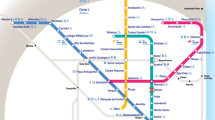Abstract
Smart card systems have become the predominant method of collecting public transport fares in Japan. Transaction data obtained through smart cards have resulted in a large amount of archived information on how passengers use public transportation. The data have the potential to be used for modeling passenger behavior and demand for public transportation. This study focused on train choices made by railway passengers. If each passenger’s train choice can be identified over a long period of time, this information would be useful for improving the customer relationship management of the railway company and for improving train timetables. The aim of this study was to develop a methodology for estimating which train is boarded by each smart card holder. This paper presents a methodology and an algorithm for estimation using long-term transaction data. To validate the computation time and accuracy of the estimation, an empirical analysis is carried out using actual transaction data provided by a railway company in Japan. The results show that the proposed method is capable of estimating passenger usage patterns from smart card transaction data collected over a long time period.













Similar content being viewed by others
References
Asakura, Y., Iryo, T., Nakajima, Y., Kusakabe, T., Takagi, Y., Kashiwadani, M.: Behavioural analysis of railway passengers using smart card data. In: Proceedings of the Urban Transport, Malta, pp. 599–608 (2008)
Bagchi, M., White, P.R.: The potential of public transport smart card data. Transp. Policy. 12(5), 464–472 (2005)
Chu, K.K.A., Chapleau, R.: Enriching archived smart card transaction data for transit demand modeling. Transp. Res. Rec. 2063, 63–72 (2008)
Guo, Z., Wilson, N.: Transfer behavior and transfer planning in public transport systems: a case of the London Underground. Proceedings of the 11th International Conference on Advanced Systems for Public Transport, Hong Kong (2009)
Ieda, H., Akamatsu, T., Takagi, J., Hatakenaka, H.: Commuter’s benefit evaluation of train scheduling by network user equilibrium model. Infrastruct. Plan. Rev. 6, 177–184 (1988). (in Japanese)
Lehtonen, M., Rosenberg, M., Rasanen, J., Sirkia, A.: Utilization of the smart card payment system (SCPS) data in public transport planning and statistics. In: 9th World Congress on Intelligent Transport Systems, Chicago (2002)
Ministry of Land, Infrastructure, Transport and Tourism (MLIT): Final report of promotion policy on international interoperable smart card ticket system for public transport. http://www.mlit.go.jp/kisha/kisha08/01/010324_3_.html (2008). Accessed 16 April 2010 (in Japanese)
Morency, C., Trepanier, M., Agard, B.: Measuring transit use variability with smart-card data. Transp. Policy. 14(3), 193–203 (2007)
Sahin, I., Altun, Y.B.: Potential uses of electronic fare payment records for public transit agencies. ITE. J. 77(12), 22–27 (2007)
Seaborn, C., Attanucci, J., Wilson, N.: Analyzing multimodal public transport journeys in London with smart card fare payment data. Transp. Res. Rec. 2121, 55–62 (2009)
Trepanier, M., Tranchant, N., Chapleau, R.: Individual trip destination estimation in a transit smart card automated fare collection system. J. Intell. Transp. Syst. 11(1), 1–14 (2007)
Utsunomiya, M., Attanucci, J., Wilson, N.: Potential uses of transit smart card registration and transaction data to improve transit planning. Transp. Res. Rec. 1971, 119–126 (2006)
Author information
Authors and Affiliations
Corresponding author
Appendix
Appendix
To check the feasibility of the method in terms of computation time, a benchmark test was conducted using an artificial train schedule and artificial OD data. As shown in Fig. 14, the artificial schedule included two types of trains: express and local. The local trains stopped at every station. The express trains stopped at every two stations. Twenty trains were scheduled with intervals of 10 min between them. The benchmark test was conducted for several cases with different numbers of stations.
In the OD data, all of the passengers departed from the departure station of the trains and arrived at the terminal station of the trains. There were two types of passengers. One was passengers who entered the departure station at the departure time of the express train and exited the terminal station at the arrival time of the express train. The other was passengers who entered the departure station at the departure time of the local train and exited the terminal station at the arrival time of the local train. These passengers have often been observed in actual situations. The proposed method was compared with a method that enumerated all of the possible paths between the entrance and exit nodes. The algorithm of the compared method had the same algorithm shown in Fig. 6 except for part (b) and the subroutine. The shortest cost search in part (b) was skipped. In the subroutine shown in Fig. 7, the compared method searched all of the links that did not dip from the entering time of a passenger and did not exceed the exit time.
Figure 15 shows the results of the benchmark. It shows that a significant difference was seen when the number of stations was more than 12. The calculation time of the compared method grew according to the increase in the number of stations. It is remarkable that the proposed method maintained a low computation time when the number of stations increased. The computational time savings of the proposed method was due to the reduction in the number of possible combinations of transferable trains. The benchmark test verified that the proposed method can work for larger networks with many transferable trains.
Rights and permissions
About this article
Cite this article
Kusakabe, T., Iryo, T. & Asakura, Y. Estimation method for railway passengers’ train choice behavior with smart card transaction data. Transportation 37, 731–749 (2010). https://doi.org/10.1007/s11116-010-9290-0
Published:
Issue Date:
DOI: https://doi.org/10.1007/s11116-010-9290-0





